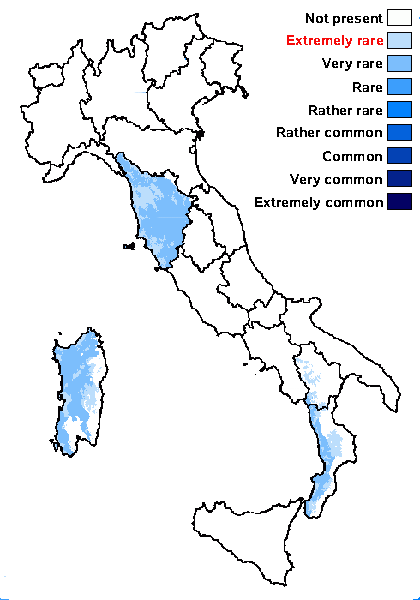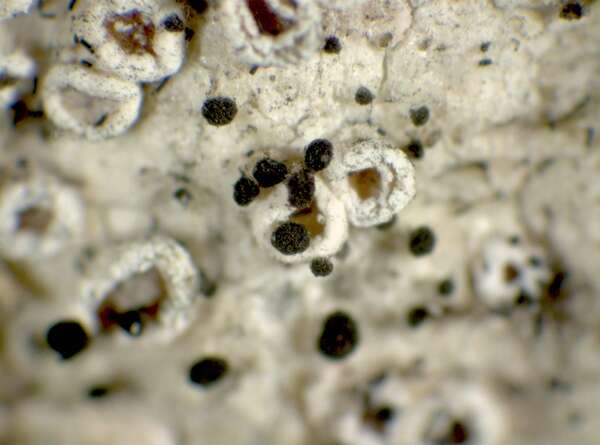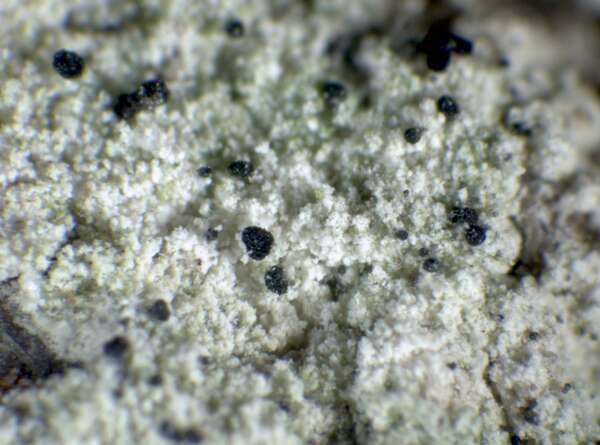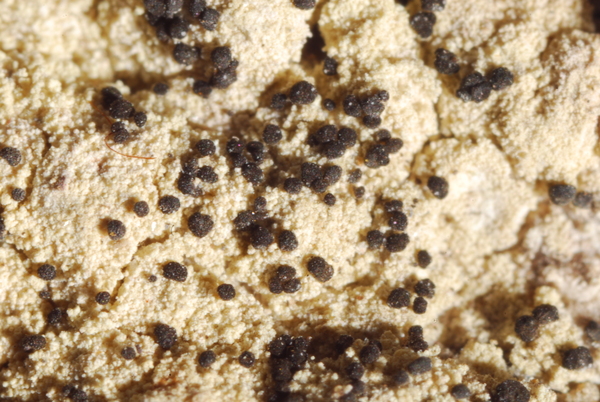Chaenothecopsis hospitans (Th. Fr.) Tibell
in Tibell & Ryman, Nova Hedwigia, 60: 202, 1995. Basionym: Calicium hospitans Th. Fr. - Bot. Not.: 40, 1865.
Synonyms: Calicium paroicum sensu Nádv. et auct.; Calicium paroicum subsp. exsertum Nyl.; Chaenothecopsis exserta (Nyl.) Tibell; Strongyleuma exsertum (Nyl.) Vain. subsp. hemileucum Vain.; Strongyleuma exsertum subsp. albipes Vain.; Strongyleuma paroicum auct. non (Ach.) Vain.
Distribution: C - Tosc (TSB 34246, Brackel 2016), Sar (CLU 3654). S - Bas (CLU 16573), Cal (Puntillo 1994, 1996, Puntillo & Puntillo 2009, Brackel & Puntillo 2016, Brackel 2016).
Description: Thallus not evident, not lichenized. Apothecia short-stalked to subsessile, 0.2-0.3 mm high, developing on the thalli of Haematomma ochroleucum. Stalk 0.06-0.1 mm thick, entirely black or pale at the base, the central part formed by hyaline hyphae, the outer part sometimes greenish grey, especially in upper part, N-. K+ fleeting red. Capitulum hemispherical or lenticular, 0.15-0.35 mm across; mazaedium not present. Exciple grey-green in lowermost and outer parts, 10-14 µm thick, consisting of 3-5 layers of periclinally arranged hyphae, N-, K+ fleeting red; epithecium colourless; hypothecium colourless to pale brown. Asci 8-spored, cylindrical, with a thickened apex penetrated by a narrow canal, formed singly, persisting until the uniseriately arranged spores are mature. Ascospores 1-celled, dark brown, slightly fusiform to broadly ellipsoid, 8-10 x 4-5 µm, the wall minutely ornamented. Photobiont absent. Spot tests: exciple and stalk K+ fleeting but strongly red, C-, KC-, P-, N-. Chemistry: without lichen substances, except a yellowish to red, unidentified pigment reacting K+ red in exciple and stalk.Note: parasitic or parasymbiont on the thalli of Haematomma ochroleucum beneath overhangs of basic siliceous rocks protected from rain below the subalpine belt; probably more widespread in Tyrrhenian Italy.
Growth form: Lichenicolous fungus
Substrata: rocks
Reproductive strategy: mainly sexual
In underhangs rarely wetted by rain
paras Haematomma ochroleucum
Commonnes-rarity: (info)
Alpine belt: absent
Subalpine belt: absent
Oromediterranean belt: absent
Montane belt: extremely rare
Submediterranean belt: absent
Padanian area: absent
Humid submediterranean belt: very rare
Humid mediterranean belt: extremely rare
Dry mediterranean belt: absent

Predictive model
Herbarium samples
Growth form: Lichenicolous fungus
Substrata: rocks
Reproductive strategy: mainly sexual
In underhangs rarely wetted by rain
paras Haematomma ochroleucum
Commonnes-rarity: (info)
Alpine belt: absent
Subalpine belt: absent
Oromediterranean belt: absent
Montane belt: extremely rare
Submediterranean belt: absent
Padanian area: absent
Humid submediterranean belt: very rare
Humid mediterranean belt: extremely rare
Dry mediterranean belt: absent

Predictive model
| Herbarium samples |
 INDEX FUNGORUM
INDEX FUNGORUM
 GBIF
GBIF





